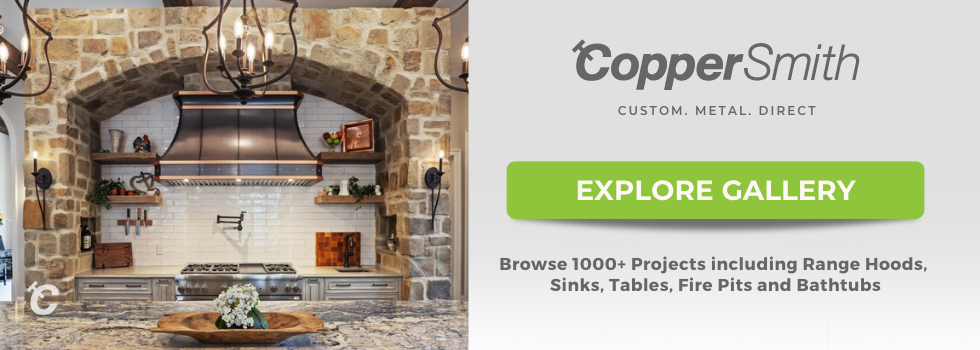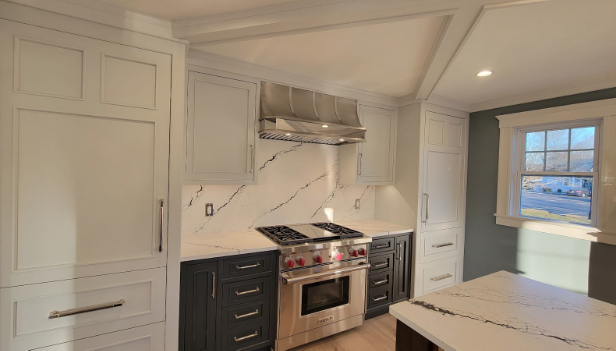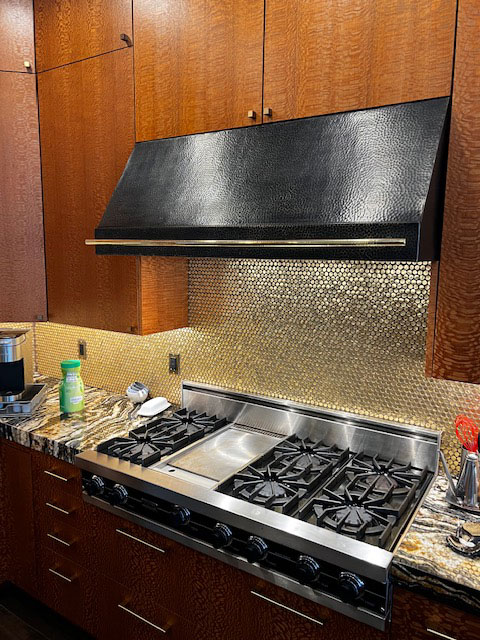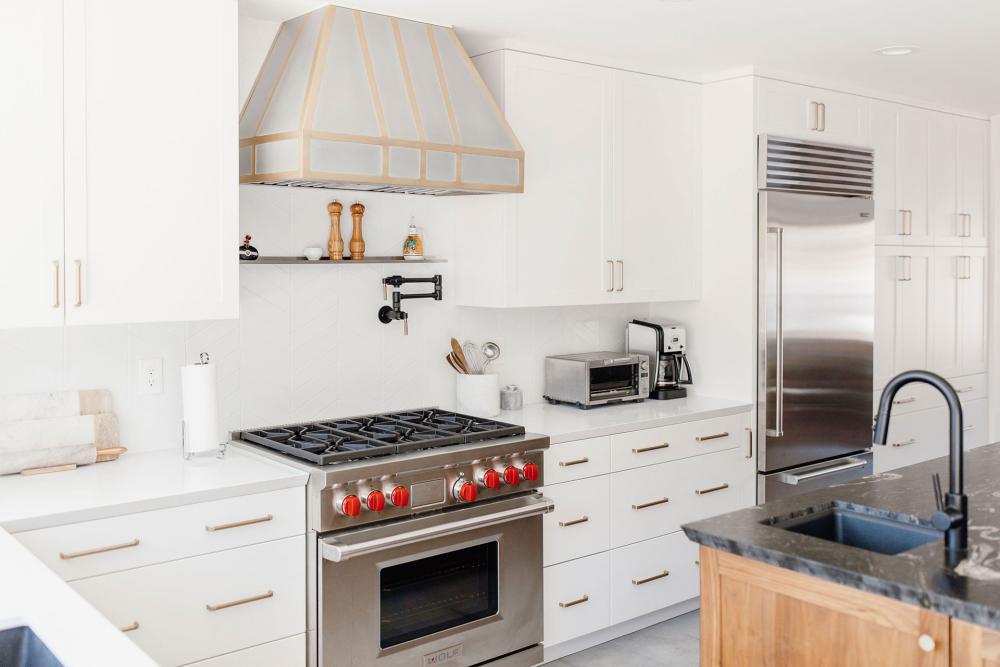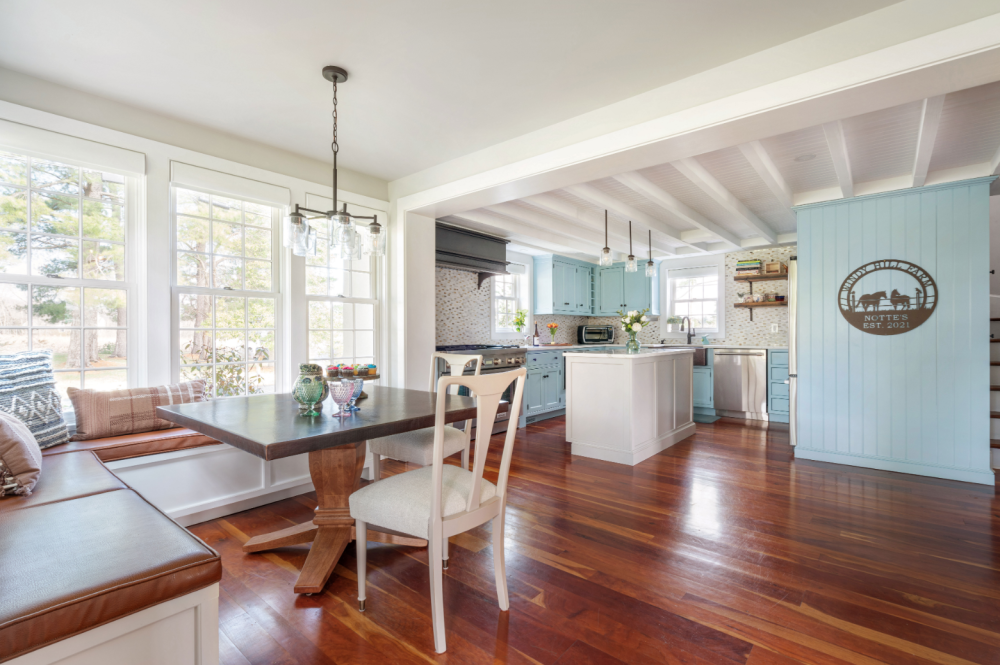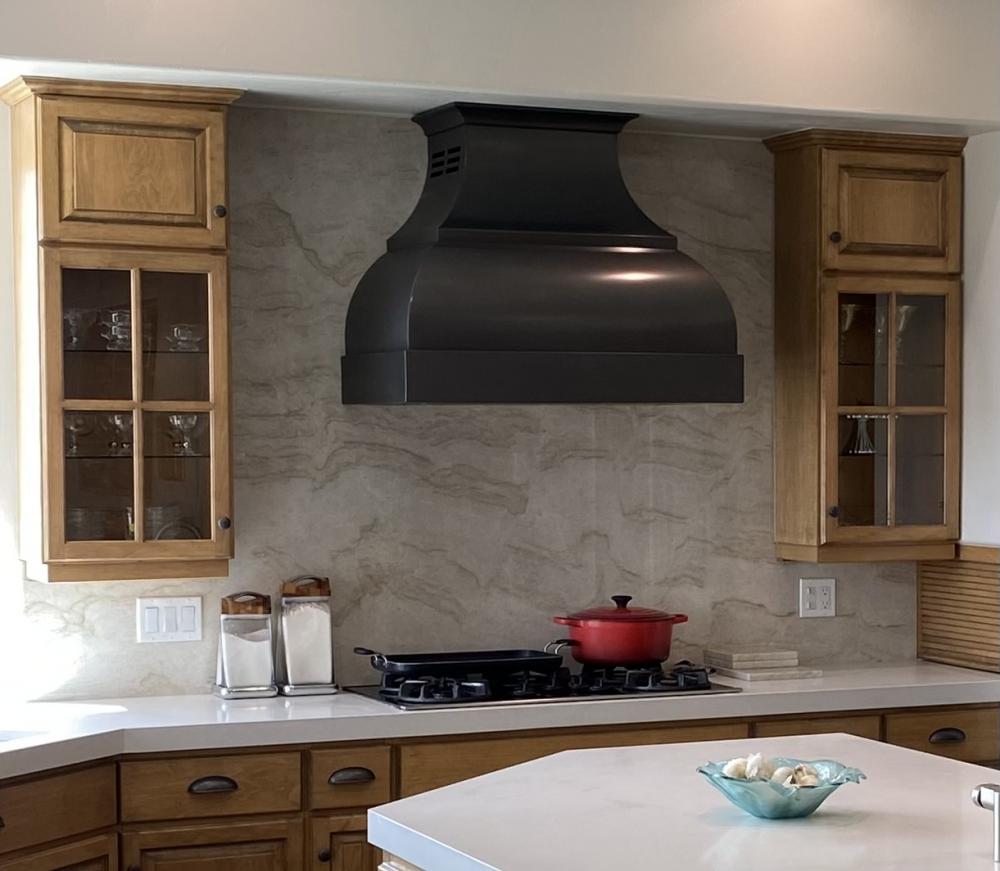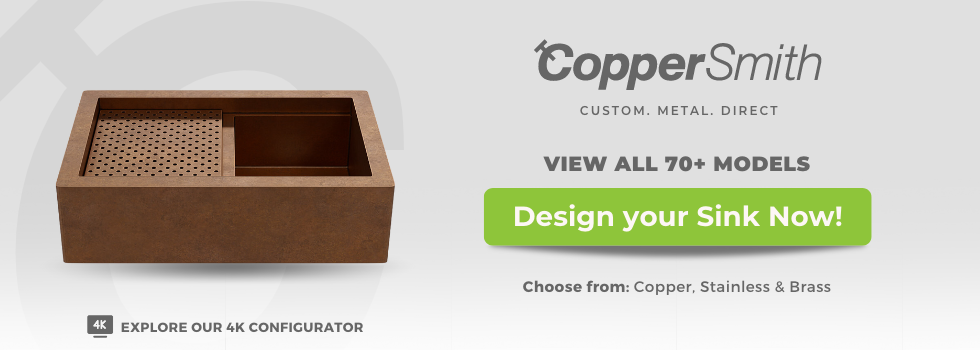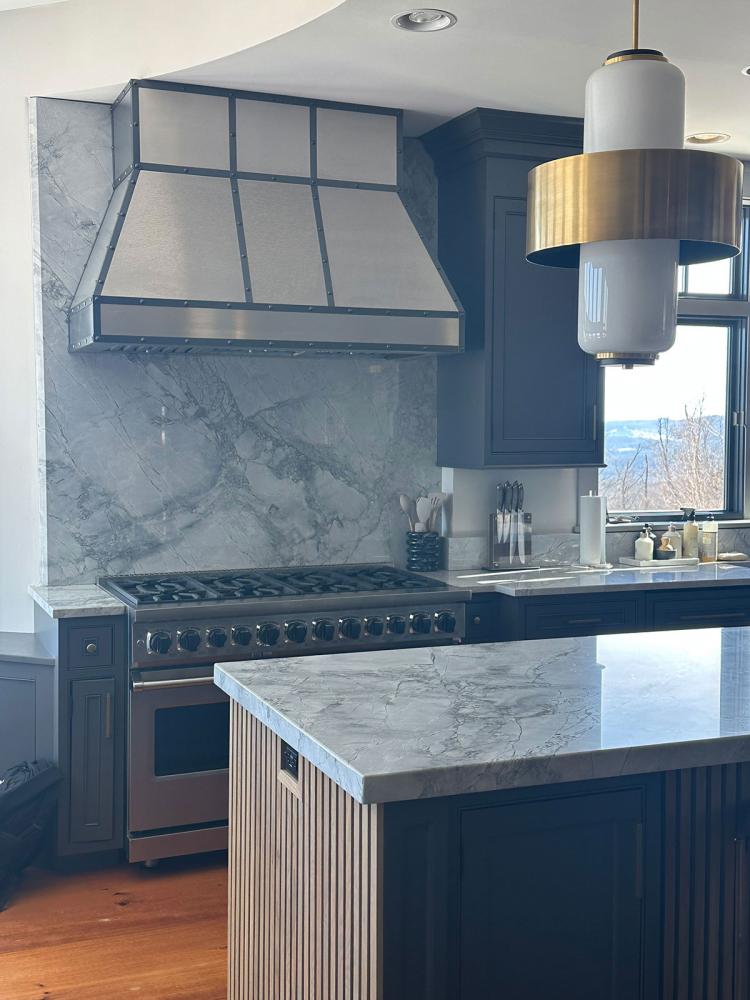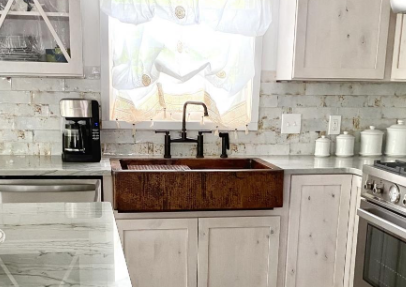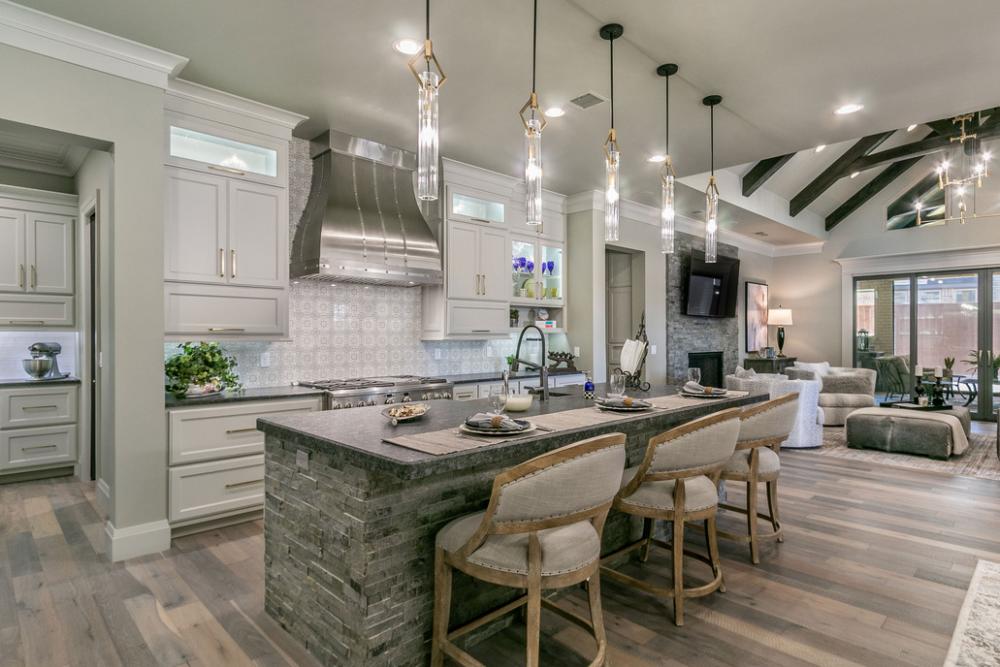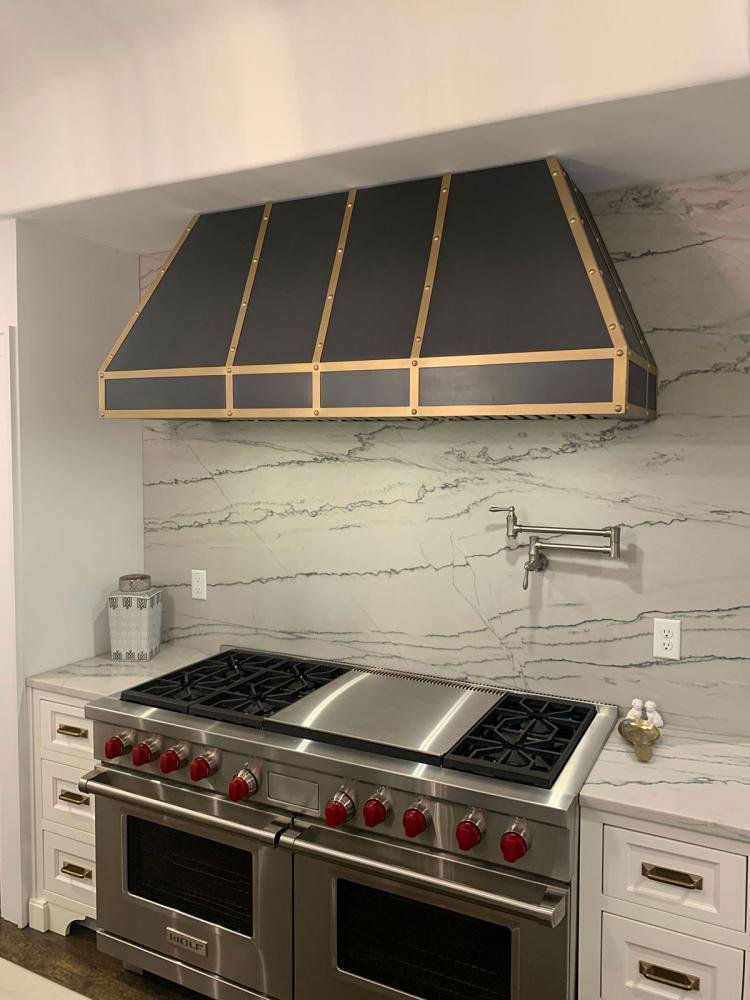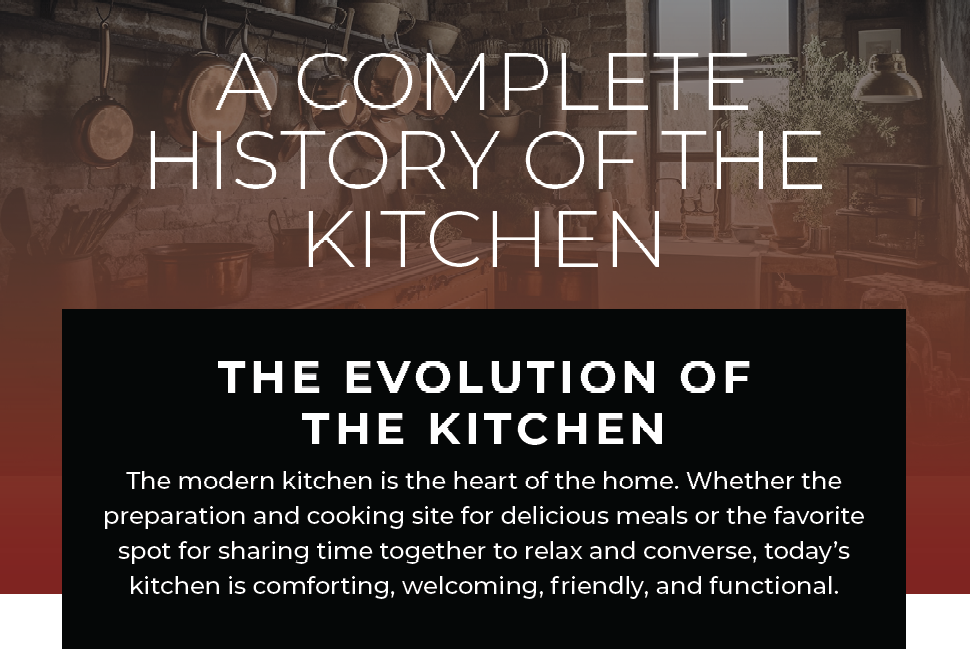
The Evolution of the Kitchen
The modern kitchen is the heart of the home. Whether the preparation and cooking site for delicious meals or the favorite spot for sharing time together to relax and converse, today’s kitchen is comforting, welcoming, friendly, and functional. Although the modern-era kitchen is practical, functional, attractive, and inviting, it wasn’t always this way. Throughout the majority of history, the kitchen existed primarily as an area to prepare food and wasn’t even necessarily located in the house itself. The English term, “kitchen” is derived from a Latin word, “coquere,” which means to cook. Join us for a journey from ancient times to the present and see for yourself how much kitchens have evolved.
The Time Before Kitchens Were Kitchens
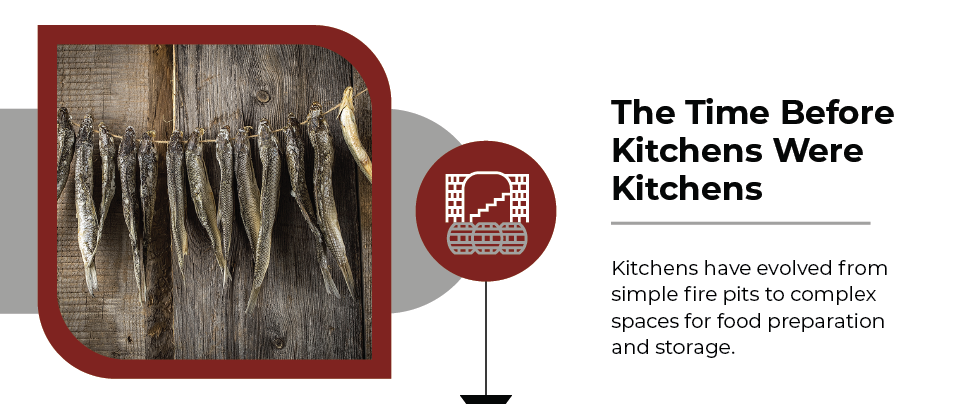
Kitchens have come a long way since ancient times, haven’t they? Originally, kitchens were not much more than pits with fire used for cooking the food. In northern China, the remains of hearths from an estimated half a million years ago were found with the remains of bones of numerous animals. There were not really kitchens in early times. Instead, there were areas for preparing and cooking food. Oftentimes, spits made from branches were positioned over a fire made in a pit. Ancient Chinese archaeological finds suggest pigsties were located close to the food preparation area, probably for convenience. Pig meat was one of the primary sources of meat consumed in ancient China. Food items were often stored in bags made from the skins of animals, gourds, or woven baskets. There were no refrigerators or even iceboxes. The very first hearths were made out of clay or stone. One of the main purposes of the hearth was to contain the fire while cooking. The risk of fire was always high. Many times, the hearth completely encircled the fire to help keep it from spreading to the home.
Ancient Egyptian Kitchens
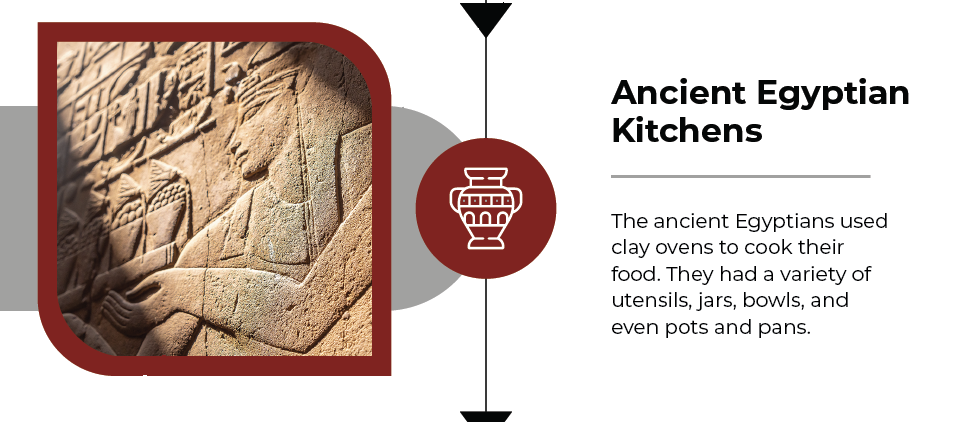
In ancient Egypt, both wood and charcoal were used to burn as fuel for cooking. The ancient Egyptians used clay ovens to cook their food. They had a variety of utensils, jars, bowls, and even pots and pans.
Ancient Greeks
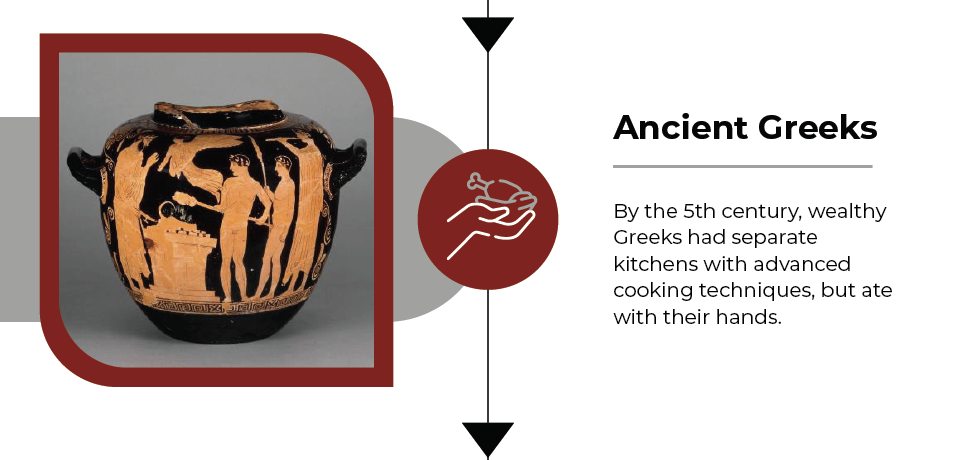
By the 5th century, wealthy Greeks were constructing a kitchen structure separate from the rest of the house. A small storage room located near the back of the kitchen was used for utensils. The Greeks preserved their meats by using smoking, drying, and salting techniques. They also fished and used olive oil. A spit was positioned over a large fire. The meat roasted evenly as the spit manually turned. The ancient Greeks also had a clay oven that was very much like modern-day pizza ovens. Lamb and vegetables or a similar dish would be placed in the oven for a few hours or buried in the ground over hot coals. There weren't eating utensils in ancient Greece. Everyone ate meals using their hands or bread.
Kitchens in Ancient Rome
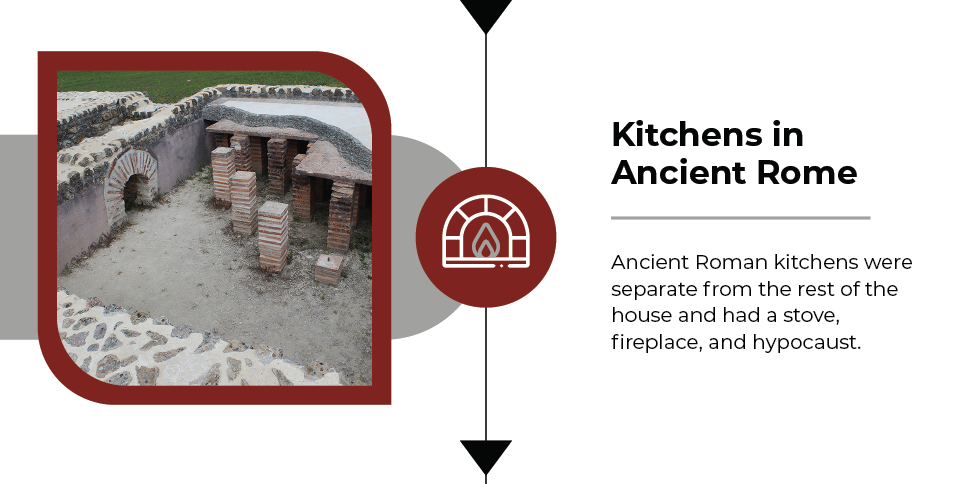
Ancient Romans followed the Greek format of keeping the kitchen separated from the rest of the house. Throughout history, a socioeconomic influence is seen in the size and design of the kitchen, even in ancient Rome. Wealthy Romans often had grape crops located in a country estate. The grapes were made into wine. Often olives and wheat were also grown. The crops were harvested and brought back to the city home in Rome. Roman kitchens had extra space to accommodate the country harvests. The Romans had actual kitchens that included a stove and an open fireplace for roasting. The stove was typically placed against the wall but occasionally, portable stoves were made. The ancient Romans also invented a type of centralized heating system which used the open fireplace to generate heat for a room or even multiple rooms. The hypocaust was a system of warming pipes under the floor which carried hot air from the fire to all parts of the room. It could also heat water for a bath.
Kitchens in the Middle Ages
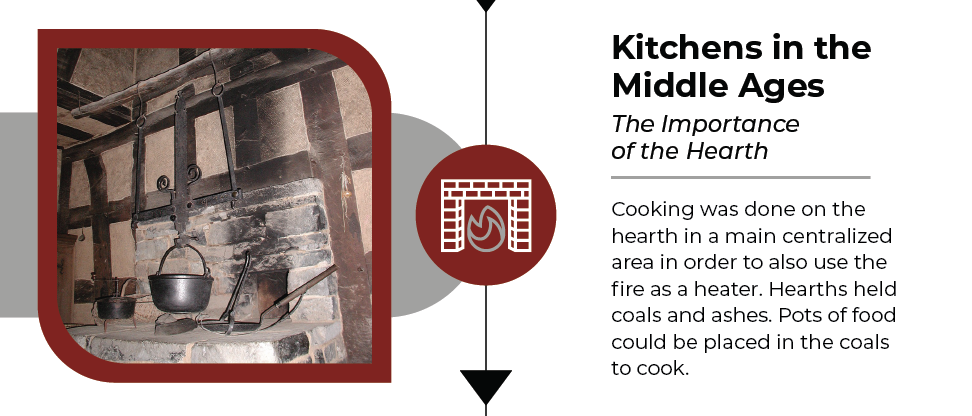
The Importance of the Hearth
European countries did not adopt the Roman central heating system. Instead, they continued to rely on a hearth with an open fire. Cooking was done on the hearth in a main centralized area in order to also use the fire as a heater. Hearths held coals and ashes. Pots of food could be placed in the coals to cook. Rotating spits cooked large pieces of meat. The heat generated by the hearth was used for more than cooking whenever possible. In Russia, some hearths were designed to allow laundry to dry. According to the Old Farmer’s Almanac, the first wood-burning stove was invented in Europe in the 1500s. Strangely, it took almost 200 years for the stove to become a common fixture in kitchens. Fireplaces with chimneys were built in castles in Northern Europe by 1000 A.D. For the most part, fireplaces were only seen in the wealthiest homes even as late as 1600 A.D. When fireplaces did start appearing in the homes of commoners, they were usually constructed of common mud and wattle. Wattle was made of vertical rods woven together with horizontal reeds. These were very flammable. Wealthy households enjoyed fireplaces made of brick or stone. Fireplaces were much more efficient than the open fires in hearths. By the 19th century, stoves and hearths were becoming much more sophisticated. Still, kitchens remained far from our current-day vision of a typical kitchen. Functionality remained the main objective of kitchens in the Middle Ages. Kitchens were still kept separate from the rest of the home until the late Middle Ages when separate kitchens started to appear. During this time, fireplaces were placed along the walls. Kitchens were located away from the main building to avoid the smells and noise of the kitchen from bothering guests. Keeping the kitchen fire away from the main house was also done to prevent a fire hazard.
What Kinds of Utensils Existed during the Middle Ages?
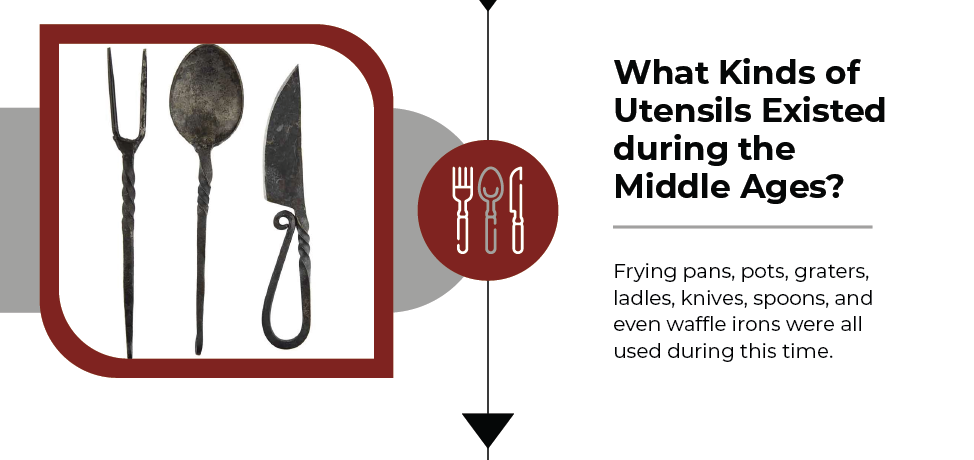
You may wonder what kinds of cooking utensils were used hundreds of years ago. Actually, many of the utensils and tools were much like ours today. Frying pans, pots, graters, ladles, knives, spoons, and even waffle irons were all used during this time.
Food Preservation in the Middle Ages
The Pantry
Larger, wealthier homes and castles had a pantry, larder, a buttery, and often a smokehouse. The pantry was a food storage and preparation area. Bread was kept there as well as other shelf-stable foods.
The Larder
The larder was the closest thing to a refrigerator. It had to keep food cool and insects (like flies) and critters out. Different regions used different terms for these storage rooms. For example, in Scotland, larders were known as spences. In more modest homes, the larder was called a cellar as it was generally located below the ground to keep the temperature cool.
The Buttery
Wealthy homes and castles had another room related to the kitchen: the buttery. The buttery was not what it sounds like. Beer kegs were stored in the buttery. Oftentimes, a staircase led to a beer cellar underneath. The wine cellar was located in a different area.
Root Cellar
Eventually, the term cellar referred to the rooms located under the main floor. Root cellars were not refrigerators but kept food cool even throughout the hot months of summer. During winter, the cellars maintained a consistent temperature.
Smokehouse
Meat and fish could be preserved in the smokehouse. Canning, preserving, pickling, and smoking were all important parts of food preservation in the Middle Ages.
Kitchens In The 1600s
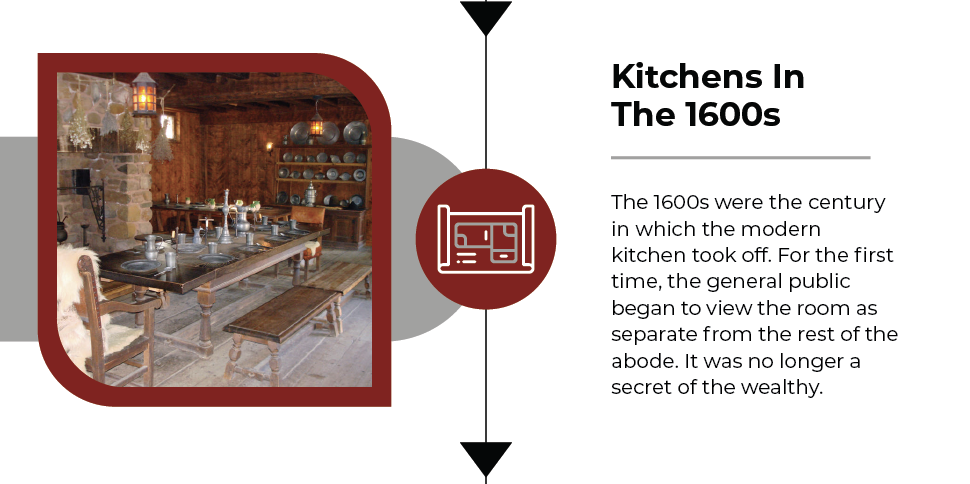
The 1600s were the century in which the modern kitchen took off. For the first time, the general public began to view the room as separate from the rest of the abode. It was no longer a secret of the wealthy.
The first modern kitchens began appearing in England. Partly, this change had to do with the growing wealth of the land. The country became wealthier than France on a per capita basis in the 1600s, making it nearly as rich as the Netherlands, the global superpower at the time. That new wealth drove changes in urban living, allowing more people to afford a separate cooking space.
However, some commentators believe the shift towards modern interior kitchens was a consequence of the wet and dreary British weather. While Southern Europeans could cook outside in the dry air for most of the year, the English had to deal with wet, murky, and cold conditions year-round. Food processing could occur outside on the continent, but this domestic chore was significantly less pleasant in the British Isles.
Changes were relatively swift. At the start of the 1600s, most Londoners relied on street food to satisfy their hunger. But as the century wore on, more tenement dwellers began requesting a ground-level hearth and a hole in the ceiling to let smoke escape. Slowly, the enhanced design became more standard, and cooking activities came indoors. Locals would use their kitchens to cook and consume potage, a mixture of boiled grains, pulses, and vegetables. Steam from the cooking and smoke from the fire could escape through a proto-chimney, keeping the air inside the dwelling relatively clear.
The extravagance of these early-1600s kitchens depended on the wealth of the owners. London’s emerging merchant class could afford more substantial structures and even separate rooms for household assistants to prepare food. Workers, clerks, and other laborers might only afford a simple fire pit, or no separate cooking facilities at all.
The 1600s also saw a critical change in the kitchen layout. Building designers moved the hearth to a wall and affixed a stone, brick, or timber chimney above it. This arrangement meant that most of the smoke escaped into the air and didn’t enter the home. Other innovations followed, including a separate boiler for water, a fully-enclosed fire, and, occasionally, an oven.
Kitchens in Colonial America
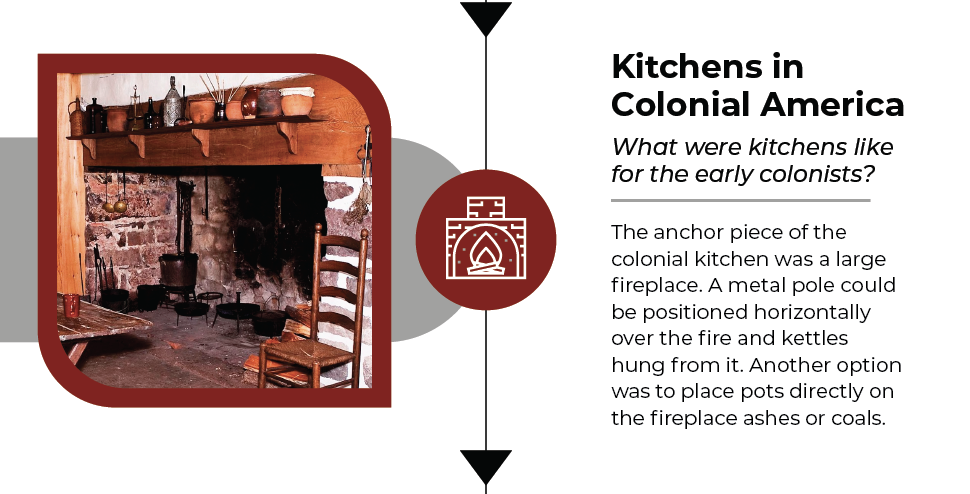
What were kitchens like for the early colonists?
The anchor piece of the colonial kitchen was a large fireplace. A metal pole could be positioned horizontally over the fire and kettles hung from it. Another option was to place pots directly on the fireplace ashes or coals. Fireplaces had a large mantle. The fire poke, cooking utensils, and other kitchen items like kettles rested on the mantle. Early sinks were simple. Oftentimes buckets or containers for holding water served as the first indoor kitchen sinks. There was no indoor plumbing, so water needed to be collected by hand from a nearby stream or water source and brought indoors. When finished with the kitchen water, it was dumped outside, maybe on the crops.
A Time of Rapid Innovation
Benjamin Franklin invented an improvement to the traditional wood-burning stove in response to a wood shortage in the Philadelphia area at the time. This was known as the “Pennsylvania Fireplace.” Ben’s invention allowed the smoke from the fireplace to burn much more completely. This allowed more heat to be released. The purpose of the Franklin stove was primarily for heating the room. Count Rumford (AKA Benjamin Thompson) Another Benjamin, Benjamin Thompson, who was called Count Rumford, was an inventor from Woburn, MA. He designed one of the earliest cooking ranges. This was a stove combined with an oven. Thompson also invented the Thermos and the Rumford fireplace. He also designed pots and pans and the Rumford Roaster. Another improvement, the cast-iron stove was invented in Sweden. This would forever change kitchen design. Early American kitchens were not only designated for eating. Oftentimes, the kitchen area was used not only for preparing food, but also bathing, and sometimes as a bedroom. In middle and upper-class homes, a household staff managed full kitchens and served the families.
Kitchens of the Famous: George Washington, first President of the United States
George Washington’s Mount Vernon kitchen was separate from the main house for the same reason most kitchens of the period were located in the back or separate from the main part of the home. The danger of fire spreading to the house, the smell of the food as it cooked, and the excessive heat of the kitchen were all factors in keeping the kitchen area separate. A complete renovation of the Mount Vernon kitchen was underway in 1775 when George Washington left to command the American troops during critical Revolutionary War battles. The new kitchen consisted of four rooms, including a loft above the kitchen where the cook could live. Another of the rooms was the food prep and dishwashing room, and one served as a larder. There was a cooling floor so food could be stored. The cooking room had a fireplace and an oven. George Washington’s kitchen featured pewter ice cream holders, pots and pans, a griddle, chafing dishes, coffeepots, and other cookware. A spit was located inside the fireplace. It rotated to ensure even cooking. Specialties were Virginia Hams and perhaps freshly-caught fish since it was one of George Washinton’s favorite foods. Cooks arose at four in the morning to light the fireplace and prepare the oven. Martha Washington oversaw the menu. Much of the food was harvested from the crops of the Washington estate. You can take a virtual tour of George Washington’s Mount Vernon kitchen.
Why Has Copper Been So Popular in the Kitchen Throughout History?
Copper has been the choice for cooking for hundreds of years. Impressive collections of copper cookware, from stock pots, to pans, to saute pans and everything in between can be seen from kitchens past. Copper is an outstanding conductor of heat.
Kitchens in America in the 1800s
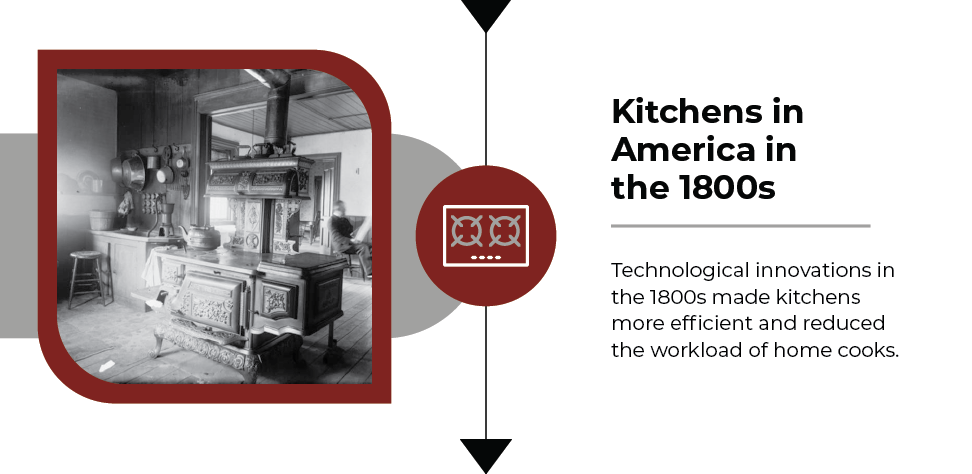
Even in the 1800s, technological innovations were improving kitchens and reducing the workload of home cooks. Coal cooking eventually made way for gas, cast iron yielded major improvements, and electricity and water that could be piped directly into the kitchen all set the backdrop for the evolution of kitchens into the present day. In the early 1800s, servants often still performed many of the household chores including meal preparation and cooking. Kitchens were often located on the bottom floor, out of the way of the main entrance where visitors and guests were present. Many Americans in the 1800s were farmers and many kitchen ingredients came from the land. The icehouse was the closest thing to a refrigerator during this period. It was an underground area with ice that was covered with straw. Sometimes the icehouse was a stone building. The kitchen was still usually separate from the rest of the house. A huge fireplace was used for cooking. It generated an incredible amount of heat. Range hoods did not yet exist in these kitchens. The kitchen of this era was hot, sooty, and smelly. Electricity was not an option for the kitchen. Windows or tallow candles provided the light.
Kitchen Sink
Around 1820, the type of sink that resembled what most of us think of as the kitchen sink began to take shape. Known as a “dry sink,” it consisted of a large bowl-like vessel made of metal, stone, or even wood. It was placed on a cabinet or sometimes a window sill. Sometimes these sinks were lined with lead or zinc. A wealthy home may have had a “wet sink.” With a wet sink, water was accessible via a pump system. The water still had to be emptied manually.
Kitchen Table
Wooden kitchen tables also served as the food preparation area. The word table is derived from the Latin word tabula. For many years, the kitchen table was designed less for socializing purposes and more for practicality.
Kitchen Tools and Utensils
Common cooking utensils of the time included wooden bowls, spoons, and a mortar and pestle. Skillets were made out of iron. Assembling ingredients, preparation, and cooking everything from scratch over the fire took considerable time, even for dishes we now think of as simple to prepare. Temperature was not exact when cooking over a fire, so probably more than a few dinners were charred.
Oberlin Stove
By the 1850s, the industrial revolution brought factories, inventions, and change to the kitchen. A stove constructed of iron, called the Oberlin stove, was much better to cook on compared to the giant fireplace of earlier decades. The stove was very popular. It performed well in cold or hot environments. Whereas the Franklin stove was mainly for heating, the Oberlin stove provided heat - and a lot of it - but also slashed cooking times. The Oberlin stove burned wood but was much safer than the old fireplaces. Because of the amount of heat it generated, kitchens were still separate rooms at the back of the house. Kitchen sinks were often a tub that could be filled with water. The tub could sit inside a cupboard or sit on the floor. By the turn of the century, many Americans began to relocate into cities. The availability of gas and running water enabled the home kitchen to transform yet again.
20th Century Kitchens
Turn of the Century Kitchens: 1900s
Kitchens from the early 1900s were much more advanced than their predecessors, but still far from what we expect kitchens to be like today. The entire home was becoming much more modern by the turn of the 20th century. A transformation was taking place that touched all aspects of the American lifestyle. As cable cars improved transportation options, it became possible to make more frequent trips to the store. It was not necessary to store large amounts of food. Kitchens were being connected to the municipal water system which made cooking and cleaning up much more sanitary, efficient, and easy. Another huge improvement was the arrival of gas ranges in American kitchens. Imagine, no more slaving over hot coal stoves.
Kitchen Sinks
By around 1902, the old-fashioned stone, ceramic, or wooden sinks were replaced by enamel, granite, and steel. Plumbing modernized kitchen sinks and drainpipes eliminated the need to manually port the sink water outside to dispose of it. Early sinks were mounted to walls and they had legs like furniture. Sometimes they came with drainboards. The same system is still used in present-day Italy in some small villages. The sinks were not yet integrated seamlessly with the countertops. In the kitchen, furniture was still freestanding. Built-in kitchen cabinets were not yet common.
Cupboards and Countertops
In the early 1900s, countertops, if there were any in the kitchen, were made of wood. A Butler’s pantry, constructed of wood, was often located between the kitchen and dining room. It was used to store the dishes. The Hoosier wooden cabinet featured ample storage space for pantry items, spices, and a pull-out workspace so the modern cook had everything conveniently within reach. First sold in 1898, the Hoosier had fallen out of favor with American housewives by the 1940s. Similar cabinet designs remain popular in parts of Europe to the present. Linoleum floors became popular during this time. Printed linoleums were offered in a wide array of patterns.
The Refrigerator
The refrigerator was invented by General Electric (GE) in 1911. The first refrigerator in American homes, however, did not arrive until 1927. The first refrigerators were more expensive than a Model T car. GE’s Monitor Top refrigerator cost $525. A Ford Model T at that time cost about $300. Although the refrigerator was invented in 1911, the majority of Americans did not have refrigerators similar to today’s refrigerators until the 1940s. Until that time, most Americans had what was called an icebox in their kitchen. The icebox was really a type of cabinet, insulated, with a space for a block of ice to be inserted. The iceman delivered a block of ice to the home, usually on a weekly basis.
The Stove: Cast Iron Stoves and Gas Stoves
Although cast iron existed in China as early as 600 B.C., the first cast iron stove in the United States was manufactured in Lynn, Massachusetts in 1642. In small homes, the main heat source of a family was the cast iron stove. It had to do at least double-duty as the kitchen cooking appliance and also the heating system for the home. Sometimes it was also used to dry clothes. As mentioned earlier, Benjamin Franklin made some stove design improvements, but overall, the design of the cast-iron stove remained the same for over 200 years. Gas stoves gained popularity in the early 1900s as the cost of gas became more affordable. Gas stoves rapidly became more popular than cast iron stoves. Gas stoves or ranges were constructed of sheet metal and cast iron. The finish was often a baked-on enamel. The gas stove emitted much less heat than the old-style stoves. An oven was located to the side on the top, with the broiler below.
Pop-Up Toaster
The world’s first pop-up toaster was invented in 1919. Toasters did not become hugely popular until the 1960s when they became much more affordable. Interestingly, at the time the first toaster was invented, store-bought sliced bread did not yet exist.
What Did Kitchens Look Like in the 1920s?
In the 1920s, technological and social changes influenced the evolution of kitchens. Now electricity and natural gas were in many homes. Hired staff was less common than before, so a housewife needed to accomplish a lot herself. Houses tended to be smaller than in the past decades. Although functionality was paramount, design and stylistic touches were also important. Previously, freestanding cabinets and furniture stored pantry items and provided food preparation space.
The Frankfurt Kitchen: Margarete Schütte-Lihotzky
In Frankfurt, Germany in the 1920s, designer Margarete Schütte-Lihotzky presented a concept that would have a transformational impact on kitchens throughout modern times. Her idea was to separate the kitchen from the living area so that the kitchen was chiefly for the preparation and cooking of food. She divided the kitchen from the living room and closed it off as a separate room via a sliding door. Margarete Schütte-Lihotzky’s kitchen concept became known as the “Frankfurt Kitchen,” in reference to the cost-saving, efficient kitchens in public housing apartments after World War I in Frankfurt, Germany. The rationale behind Schütte-Lihotzky’s kitchen design was to reduce the amount of time a homemaker spent in the kitchen so she could pursue other interests. History may prove the new kitchen design had the opposite effect. By closing off the kitchen, it separated the cook from the rest of the household and she probably assumed the majority of kitchen duties instead of sharing the workload. Nevertheless, the Frankfurt Kitchen is important because it was one of the first efficiency-style kitchen prototypes. The kitchen work triangle layout of refrigerator, sink, and stove, which is still popular today, has been greatly influenced by the designs of Margarete Schütte-Lihotzky, who took her inspiration from efficiency expert Frederick Winslow Taylor.
Electricity
Electricity brought many changes and time-saving innovations to the kitchen. Electric light bulbs replaced kerosene lamps and toasters, electric irons, and coffee percolators saved time and energy. In 1927, General Electric's “Monitor-Top” refrigerator debuted. It operated with a compression system located on top and represented an improvement over the traditional icebox. Iceboxes remained popular in the ‘20s, in part because they were much less expensive. In 1928, Toastmaster debuted the electric toaster. It had adjustable settings and quickly became a necessity in American kitchens. KitchenAid, originally owned by Whirlpool, first entered kitchens in the 1920s.
Range Hoods
Early kitchens were often smoky, hot, smelly, and without adequate ventilation. Range hoods are important because they keep the kitchen much cooler, improve the quality of the air you breathe, and can be an attractive part of the kitchen decor. Although range hoods existed before the 1920s, this decade saw many patent registrations for range hood modifications and improvements. Fans for catching fumes and venting them out of the kitchen marked notable improvements.
Sanitary Kitchens
The post-World War I era was marked on the home front by an increased understanding and scrutiny of hygiene and sanitation measures to eliminate bacteria and other germs. Walls were light colors, commonly white, but also yellow or even earth-toned shades. Washable tiles sometimes covered parts of the walls. Linoleum for kitchen flooring was practical and easy to clean. Stoves, tabletops, and pans were covered with porcelain enamel. The kitchen of the 1920s evolved as the importance of good nutrition and attention to sanitation increased.
1930s Kitchens Styles, and Designs
The Great Depression was a time of scarcity and restraint. Perhaps partially in response to the economic crisis of the time, kitchens in the 1930s were bright, inviting, and friendly. Industrialization, better allocation of utilities like electricity, gas, and water, as well as lowered costs for appliances, transformed the purpose and design of the kitchen. Also, more women who originally worked as domestic servants before World War I, instead pursued jobs in nursing, as teachers, in retail, and in factories after the war. The luxury of families to employ staff in the home to cook and clean was no longer possible after the economic damage caused by the Great Depression. Manufacturers recognized the opportunities to market appliances to fill the gap. A more modern-looking kitchen was emerging, with freestanding furniture being replaced by built-in cabinets. Heights of cabinets and kitchen countertops became standardized.
Timesaving Kitchen Appliances in the 1930s
Look and function was prioritized in kitchens. Increasing efficiency by organizing kitchen appliances so they were within easy reach saved the busy homemaker time. The blender was originally invented and patented in 1922 by Stephen Poplawski to make soda fountain drinks. The household blender we are familiar with was not released until over a decade later by the Waring Corporation. After several prototypes, Fred Waring released the Waring Miracle Mixer Blender in 1937 for $29.75. The Sunbeam Mixmaster was invented in 1928 and first sold to the public in 1930. At a time when the majority of cooking was still done by hand, the Mixmaster’s multitasking capabilities and many attachments were impressive. It could mix batter, serve as a coffee grinder, knife sharpener, meat grinder, juicer, chop, slice vegetables, and peel potatoes.
KitchenAid Stand Mixer
The first KitchenAid Stand Mixer prototype was created by the Hobart Manufacturing Company. An engineer for the Hobart company worked to develop a stand mixer to mix dough, and in 1914, the first KitchenAid mixer for commercial use was released. The Hobart stand mixer became the standard mixer on US Navy ships during World War I. The first KitchenAid mixer introduced into home kitchens in 1918 was a 10-quart model. It was perhaps too large for home kitchens of the time. Hobart and his team made adjustments and introduced the C-5 Kitchenaid mixer in 1922. It was smaller, lighter, and featured a 5-quart bowl. Although KitchenAid debuted the C-5 stand mixer in 1922, it was so popular by the late 1930s that the mixer frequently sold out. Amazingly, the design remains very much the same today. Other kitchen gadgets became beloved and indispensable kitchen additions:
- Toaster
- Ice Cream Maker
- Pie Pans
- Muffin Pans
- Dishwashing Tools like specialized brushes
Linoleum floors continued to be popular. Fold-down ironing boards could be used and then neatly folded back into the wall-mounted holder when ironing was completed. Not every cook or homemaker could afford to completely renovate the kitchen. Often, new elements and designs were brought into the kitchen one piece at a time. The transition from free-standing to efficient, built-in cabinets and the latest kitchen appliances took place gradually as time and budget allowed.
Kitchens of the 1940s
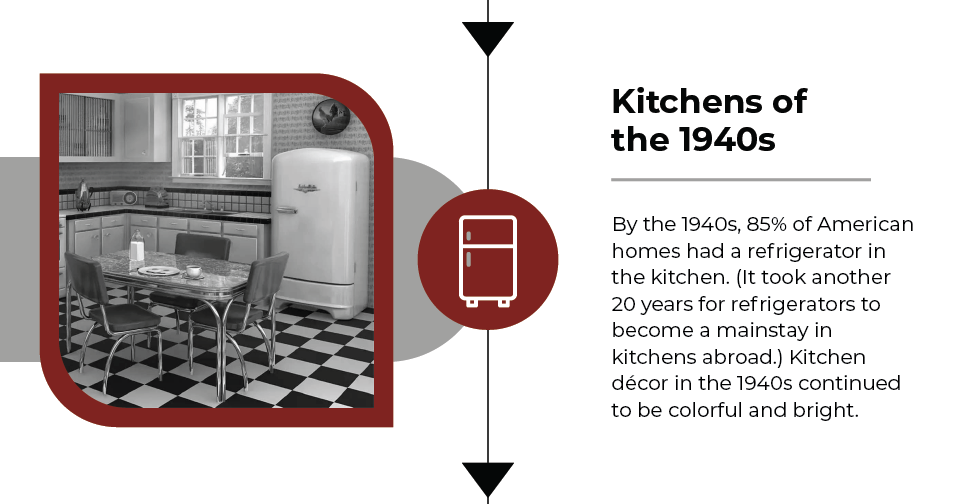
By the 1940s, 85% of American homes had a refrigerator in the kitchen. (It took another 20 years for refrigerators to become a mainstay in kitchens abroad.) Kitchen décor in the 1940s continued to be colorful and bright. Kitchens were often primarily two colors. Tile was frequently installed on the countertops. One primary color was used for the majority of the kitchen, while the trim and accents featured the other color. Turquoise green, blue, pink, canary yellow, red, and white were very popular kitchen colors. Americans in the 1940s were very patriotic, and red, white, and blue color palettes were frequently used in decorating. New kitchen innovations in the ‘40s included stylish fixtures like acrylic knobs on cabinets and bright, cheery window treatments. Bread boxes and canister sets were common in kitchens. Butcher block countertops gained popularity around this time, although other countertops were also in demand. Contrasting inset color on countertop tiles provided color interest. The backsplash was often also made of tile. Furniture in kitchens in the 1940s was also brightly colored. Chairs painted a coordinating color to match the theme of the kitchen. Bar stools often had chrome legs.
Kitchen Work Triangle
The idea behind the work triangle was that the main kitchen workhorses: the sink, stove, and refrigerator, should be arranged in a triangle fashion for maximum efficiency. Ideally, each side of the triangle was to be between four and nine feet in length. Kitchen appliances were coated in enamel. The most popular color was white enamel, but red, blue, yellow, and sometimes mint green appliances completed the kitchen design.
Tupperware
Tupperware containers were invented in Massachusetts in 1946. Within a short number of years, the plastic containers and sealable lids became popular, along with the well-known Tupperware parties. Tupperware parties really became popular around 1951, and from that point on for the next 20 years, sales of Tupperware products doubled every 5 years.
Kitchen Designers, Architects, and Influencers
After World War II, the home real estate market exploded. Homebuyers were lured to the suburbs with visions of large, luxurious kitchens compared to traditional, small, city-dweller versions.
1950s Kitchens: Streamlined Appeal
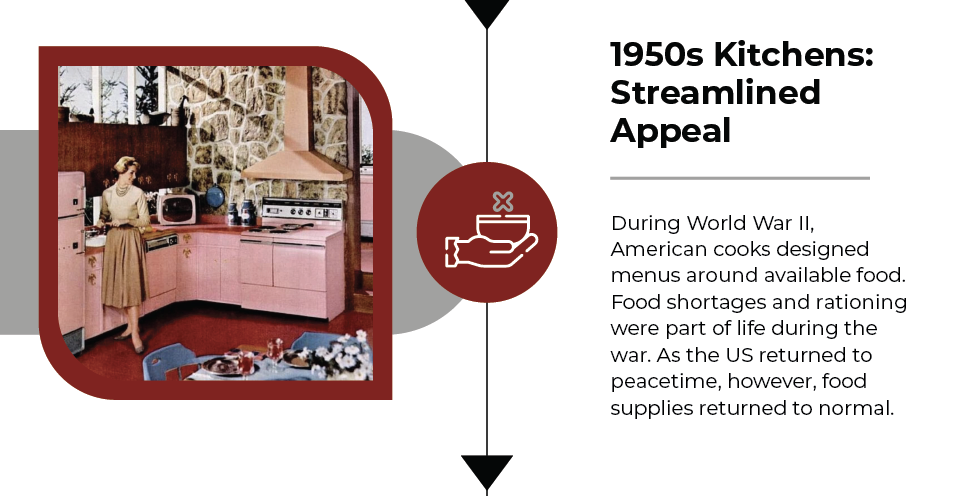
During World War II, American cooks designed menus around available food. Food shortages and rationing were part of life during the war. As the US returned to peacetime, however, food supplies returned to normal. A period of abundance began, with cupboards well-stocked to prove it. Steel factories from World War II were repurposed for domestic uses and began manufacturing kitchen cabinets as well as other products. After the war effort, the US enjoyed a time of prosperity. Soldiers returned home from the war and the housing market boomed. With that, many women returned to more domestic time with family, and the kitchen played a starring role. Bright primary colors of years past gave way to softer colors in 1950s kitchens. Shades of blue, turquoise, pastel yellow, and especially pink, were favorite kitchen color palettes. Mamie Pink was a popular color in kitchens and bathrooms during the Eisenhower years between 1953 and 1961 when Mamie Eisenhower was the First Lady. Pink was by far her favorite color. She redecorated the entire private living quarters of the White House in pink. Reporters called the redecorated sections the Pink Palace. The influence of Mamie Eisenhower’s fondness for pink was evident in kitchens throughout America.
Fitted Kitchens
The modern kitchen of the 1950s was designed in a continuous, sleek line, with built-in appliances and cabinets. Even when it was impossible to completely renovate or replace the kitchen all at once, modernizing the kitchen piece by piece was encouraged. Countertops were made of laminate, although not exclusively. Some countertops were metal or plastic with brick or plastic with wood. Scalloped wood finishing added an elegant touch. Cabinets and appliances were colored to match. Under-the-sink cabinets had an interesting feature in the 1940s and 1950s. Ventilation was frequently installed during this time to prevent excessive moisture buildup under the sink. Gadgets Stand mixers, blenders, and other time-saving appliances and gadgets became all the rage in the 1950s post-war prosperity. Electric skillets, toasters, toaster ovens, and handheld mixers were common by the ‘50s. Copper tea kettles were much-used items in many kitchens.
- Countertop dishwasher (This dishwasher was so tiny it could sit on the countertop.)
- Angel food cake device (It separated the cake into pieces!)
- Green Bean slicer
- Milkshake maker
- Ice crusher
- Hand-Crank Snow Cone Machine
- Cookie Jars (Still popular today as collectibles, decorative items, or for actual use.)
- Very colorful, coordinating canisters (Still popular in some kitchens today)
- Stovetop with built-in cutting board
- Refrigerator/Freezer built to blend into cabinets (GE Model from 1955)
Tea Kettles
The first electric tea kettle with a thermostat was introduced in 1955. Developed by Russell Hobbs, the electric tea kettle was innovative at the time because of its innovative automatic shut-off feature to prevent overheating and fire.
Refrigerators
The electric range/oven combo was a normal fixture in kitchens by the 1950s. Refrigerators cooled using freon instead of compressors. Refrigerator prototypes in the 1950s were impressive. GE created a wall-mounted refrigerator in 1952. The refrigerator was installed where upper cabinets would normally be. Another GE refrigerator innovation was the GE Refrigeration Center. This large refrigerator was wall-mounted and featured refrigerator and freezer drawers which pulled out to open. This refrigerator blended in seamlessly with the rest of the kitchen cabinets. Eating in the kitchen was popular during this era, so dining tables were commonly placed in the middle of the kitchen. Breakfast nooks provided welcoming charm.
Chrome Fixtures
Chrome was a much-desired design element in the kitchens. Fixtures like cabinet hardware and chairs frequently were made of chrome. Appliances were not boxy and square. In the 1950s, a streamlined, curvy, rounded appearance was the modern look. Formica countertops came in many colors and were usually edged with aluminum or stainless steel. Kitchen curtains and table coverings often had ruffles and floral designs.
Laminate Flooring
Laminate flooring was the trend of the 1950s, with many kitchen floors sporting a popular black and white square pattern. Linoleum flooring came in many other colors and patterns. Geometric designs and even bold stripes were common kitchen flooring options. Linoleum tiles were easy to install and reasonably priced.
Kitchens of the 1960s
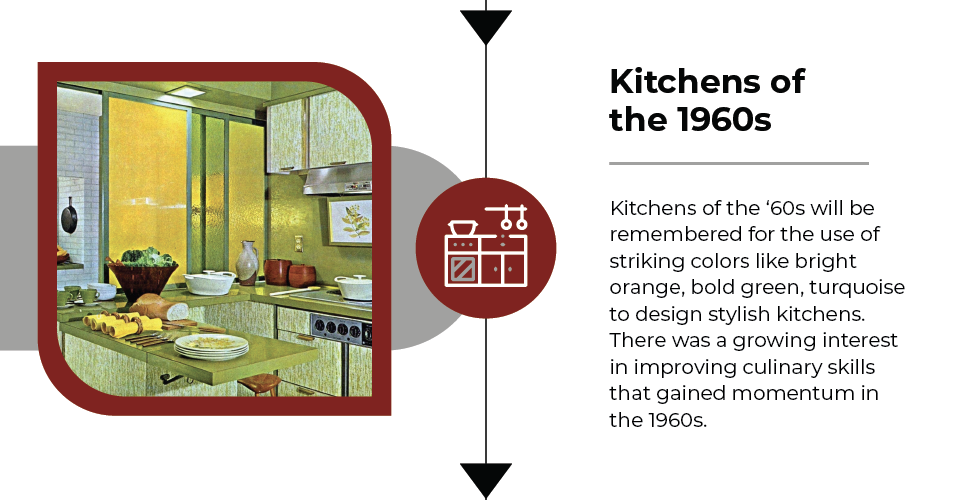
Kitchens of the ‘60s will be remembered for the use of striking colors like bright orange, bold green, turquoise to design stylish kitchens. There was a growing interest in improving culinary skills that gained momentum in the 1960s. Teflon cookware revolutionized pots and pans. Smoothies, which were made in the blender, became very popular during this era.
Teflon: An Accidental Discovery
A DuPont chemist named Roy J. Plunkett invented Teflon in 1938. The chemical Polytetrafluoroethylene (PTFE) was trademarked with the name Teflon in 1945. Plunkett was inducted into the Inventors Hall of Fame for his work with Teflon. By the early 1960s, Teflon was used in kitchens throughout the United States. Teflon was a revolutionary discovery in the 1960s. It could withstand high temperatures and had a non-stick surface. Frying pans, muffin tins, baking pans, baking sheets, and more were easy to clean thanks to the Teflon coating. *It was later found to cause cancer.
Pressure Cookers
In the 1960s, being able to prepare a meal quickly without compromising quality was a priority. Pressure cookers did exist in American kitchens in the 1950s, but by the end of that decade the quality of the cooker had deteriorated greatly, and many manufacturers went out of business. The companies with quality pressure cookers remained and resurged in popularity in the 1960s.
The Advent of the Microwave Oven
The first microwave oven was built by Raytheon in 1947 for commercial use only. It cost over $5,000 and was huge. In the 1960s, Raytheon bought the appliance manufacturer Amana and created a countertop microwave oven called Radarange for home cooks. The initial price was $495.
Immersion Blenders
Immersion blenders have been popular in Europe from the 1960s to the present. Immersion blenders didn’t become a mainstay in American kitchens until the 1980s.
Kitchens of the Famous: Chef Julia Child
Considering the legendary status Julia Child holds in the cooking world, this influential chef’s home kitchen was surprisingly low-tech. Julia Child single-handedly changed the way Americans cooked with her 1961 book, “Mastering the Art of French Cooking.” In the same year, Julia and her husband designed their kitchen. A simple kitchen table was placed in the middle of the kitchen. It was a focal point of Julia’s kitchen, and she used it for food preparation, conversing with friends and family, and eating. Her stove was a restaurant-grade stove that generated a tremendous amount of heat, requiring special ventilation and a huge hood. It was one of Julia Child’s favorite kitchen pieces but was not really intended for the majority of home kitchens. She had a refrigerator that her husband painted black, a freezer, and an icemaker. Julia had an additional refrigerator in the basement. The Julia Child kitchen featured three pantries. One contained dishes and glassware, one held copper pots and cooking tools, and one was dedicated to making pastry. Julia Child’s kitchen contained cooking tools, containers, devices and gadgets, pots and pans, and appliances everywhere you looked. Her husband helped her by constructing an ingenious wall storage system from pegboard. On it hung an extensive and beautiful collection of copper pots and cooking tools. A Polaroid photo was taken of each kitchen item and placed in the appropriate spot on the pegboard so that everything could be stored in its proper spot. Julia Child’s kitchen had linoleum flooring. Julia insisted her counters must extend beyond the cabinets underneath. This was an important feature to her for aesthetics and function: to easily brush crumbs off the countertop. Knives adhered to the wall with a strong magnetic strip. The countertops themselves had well-used butcher-block surfaces. The counters were taller than standard because Julia Child was extremely tall. The color of the kitchen was a light bluish-green color scheme. The cabinets had metal fixtures and were not inline. Julia’s kitchen had a stainless steel double sink with drainboards. One sink was for dishes and the other for food. Julia Child’s kitchen, which is now an exhibit at the Smithsonian Museum, was not a flashy celebrity kitchen. It was a bit cluttered, not on par with the latest trends, yet meticulously designed by her husband Paul for Julia according to her cooking needs and desires. Over the years, it changed very little.
What Were the 1970s Kitchens Like?
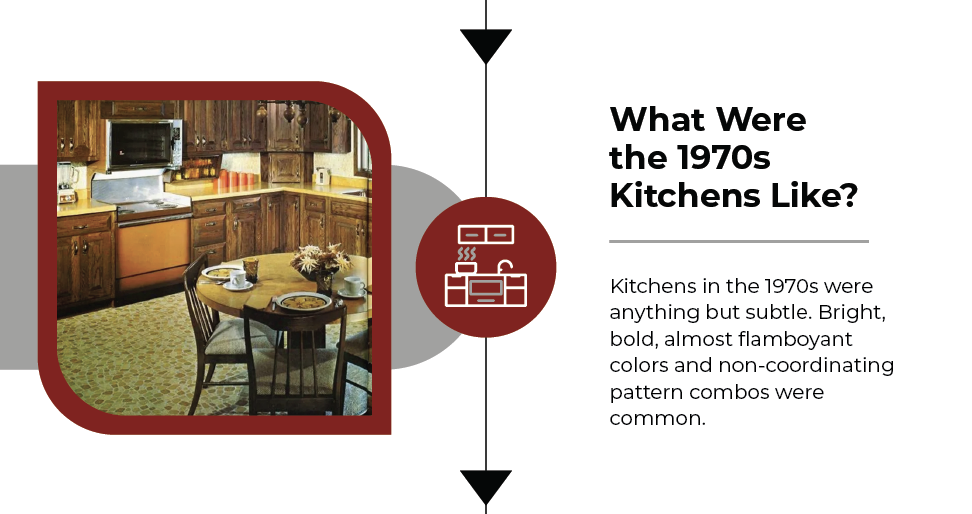
Kitchens in the 1970s were anything but subtle. Bright, bold, almost flamboyant colors and non-coordinating pattern combos were common. Perhaps the most universally recognized symbols of 1970s kitchens were avocado-colored refrigerators, ovens, dishwashers, and other appliances. Harvest gold was another kitchen design shade uniquely associated with the ‘70s.
Microwave
The microwave oven emerged as a kitchen fixture in the 1970s. The time-saving convenience of microwave cooking and the falling prices by the mid-to-late ‘70s made microwave ovens very popular. (By the mid-1980s, 25% of American kitchens were equipped with microwaves.)
Mr. Coffee Coffeemaker
Prior to 1972, coffee was usually made in a percolator. After Mr. Coffee debuted, automatic drip coffee machines grew in popularity.
Juicers
Fitness guru Jack LaLanne helped introduce juicers into home kitchens. Juicers were popular for natural food diets, healthy eating, and alternative medicine.
Slow Cooker or Crock Pot
In the 1970s, many women chose to work outside the home. Timesaving kitchen appliances were needed to get meals on the table. The Crock-Pot became extremely popular during this decade. The meal ingredients were placed in the Crock-Pot, the cook turned it on and then left for work. The meal was ready by dinner time. Modern appliances and features were the normality in kitchens of the 1970s. The designing focus was instead on transforming the kitchen into a reflection of the individual owner’s sense of style. Bright orange, striking yellow, fluorescent green colors intermingled with wooden cabinets and furniture for a unique look. Laminate cabinets and colorful Formica countertops were very popular in kitchens of the 1970s. Wild color combinations were the norm in ‘70s kitchens as freedom and individual style reigned. Cabinets in the 1970s transitioned from steel to wood. Kitchens featured ample storage options and state-of-the-art features. Wallpaper in striking patterns added flair to the 1970s kitchen design. Backsplashes were colorfully coordinated paint, tile, or wallpaper. Patterns like geometric shapes, mushrooms, and flowers were favored. Even the light fixtures reflected the creative décor of the time. Although the designs from the ‘70s may be considered unusual today, customization was an important kitchen trend.
Kitchen Designs and Themes of the 1980s
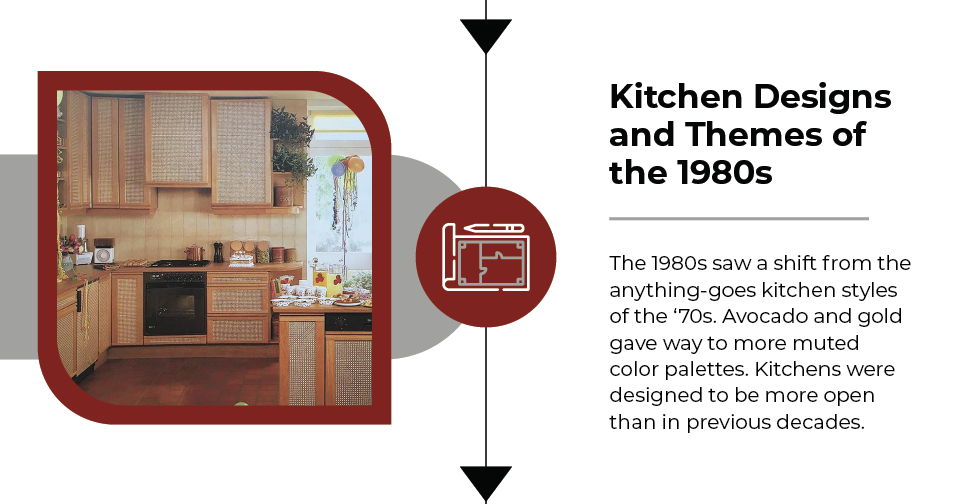
The 1980s saw a shift from the anything-goes kitchen styles of the ‘70s. Avocado and gold gave way to more muted color palettes. Kitchens were designed to be more open than in previous decades. Appliances were placed for functionality and visual appeal. Kitchens became important social gathering points for family, friends, and guests, cooking meals, telling stories, and sharing time together. The seating and appliance arrangement was designed to accommodate this. 1980s kitchens were much larger than previous generations of kitchens. Often they were open, with room for the dining area, or even opening into the living room. The kitchen had now evolved to be the most important room in the home. The kitchen reflected important social transformations. Men and women alike spent time in the kitchen, and the design, gadgets, and decor often reflected this. The larger kitchen sizes were now roomy enough for cooks sharing meal preparation.
Kitchen Islands
Kitchens were equipped with islands in previous years, but in the 1980s, kitchen islands became much more popular. They were great gathering points for spending time together while cooking a meal, preparing a snack, or even during cleanup. Kitchen islands were attractive, efficient work triangle area additions that saved busy cooks valuable time. Large kitchen islands with drawers, bins, open shelves, and a sink were popular.
Pantry
The kitchen pantry made a comeback in the 1980s. In particular, the walk-in pantry allowed for ample storage and became a popular remodeling upgrade. Appliances White or almond appliances were popular throughout the 1980s. Here are some items that gained prominence during this decade:
Food Processor
The first electric food processor was unveiled by Electrostar in 1946. Carl Sontheimer debuted the first food processor for home use in North America under the Cuisinart brand in 1973. However, it took several years for the food processor to gain popularity. By the 1980s, the multi-tasking food processor assumed a valued spot in busy American kitchens.
Trash Compactor
The trash compactor reached its peak in popularity in the 1980s. By 1992, the sale of trash compactors dropped substantially and the demand for trash compactors continued to decline.
Microwave Oven
The microwave oven was a valued kitchen appliance by the 1980s. The time-saving device was used by cooks of the ‘80s to get meals on the table faster. By the 1990s, it is estimated that 90% of US homes had a microwave oven.
Tile Counters
Kitchen counters of the ‘80s were often made of tile. Formica countertops declined in popularity. Tile counters were durable, long-lasting, and easy to clean. Tile surfaces quickly became popular in other parts of the home like the bathroom. Track lighting became popular for illuminating the kitchens. Flooring in 1980s kitchens was often vinyl, but could also be other styles like tile or terra cotta. Wallpaper borders were also frequently seen in kitchens of the time.
Laminate
Kitchen cabinets in the 1980s were often made of light oak wood, frequently with a white or ivory-toned laminate front. Oak played a prominent role in kitchens of the time and was used extensively.
American Kitchens of the 1990s
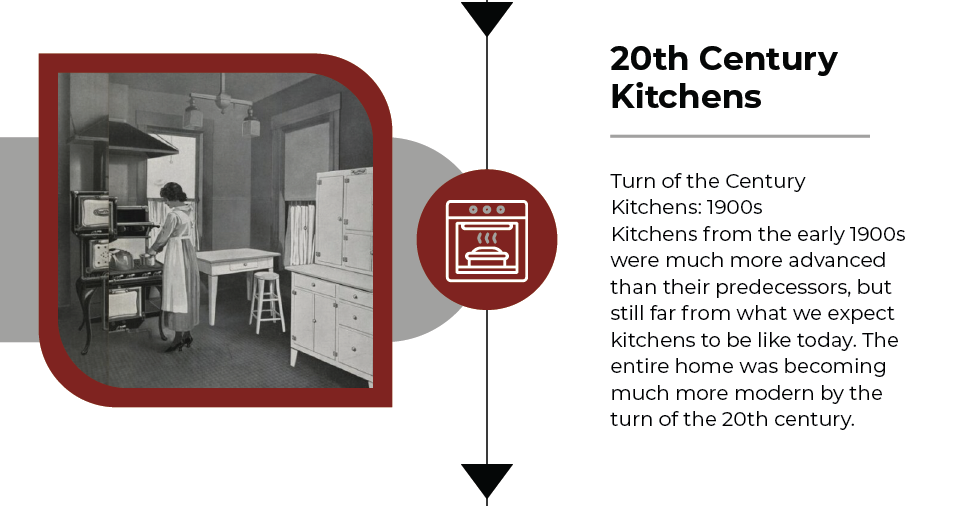
Kitchens of the ‘90s were streamlined, with the kitchen island continuing to serve as the anchor point of the kitchen. There were improvements in lighting. Country kitchens became very popular in this decade. White was an important kitchen color in the ‘90s. Soft colors, like white or beige, gave kitchens a peaceful atmosphere. Kitchens of the 1990s reflected the complete sense of individual preferences that defined the decade. Kitchen designs ranged from a nod to traditional kitchens, to modern eating areas with slate countertops, steel backsplashes, and even fiberboard cupboards. Cupboards were usually made of oak or light-colored wood with no visible handles. Appliances were one color, usually white to match the rest of the kitchen. Black was also a popular color. Popular design choices in the 1990s were granite countertops and tile floors. Pots, pans, and cooking gadgets were hung decoratively overhead for both function and style. Did you know?
First Kitchen Smart Device
The first time a kitchen toaster was controlled via the internet was in 1990. It was a Sunbeam Deluxe Automatic Radiant Control Toaster. It was the first “smart” device, but back then, there were only 3 million people on the internet!
George Foreman Grill
Launched in 1994, the George Foreman Grill brought grilling inside in a portable kitchen appliance. This was originally sold on an infomercial on the premise that it made delicious, grilled foods with minimal fat. The infomercial was one of the most successful in history.
21st Century Kitchens
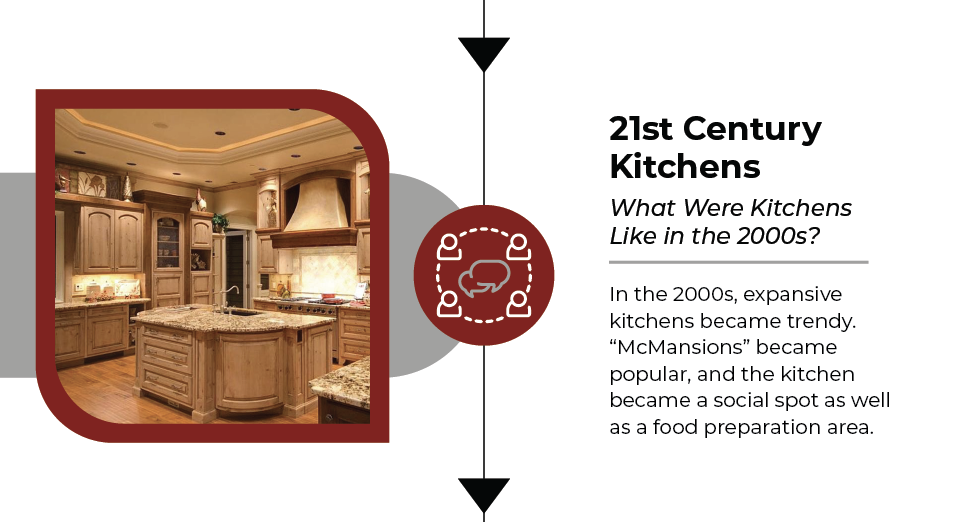
What Were Kitchens Like in the 2000s?
In the 2000s, expansive kitchens became trendy. “McMansions” became popular, and the kitchen became a social spot as well as a food preparation area. After school, children would gather in the kitchen. When friends and guests came over, the kitchen was the natural place to hang out. The turn of the 21st century saw a shift away from the comfortable country kitchens of the 1990s. Instead, sleek and shiny kitchens with dark cherry cabinets and the latest in appliances transformed kitchens. Granite countertops were the preferred choice.
Kitchen Sinks
Today sinks come in a variety of materials. Copper, granite, ceramic, and even glass offer many stylish and functional options. The most common and popular kitchen sink is made of stainless steel, but you'll find copper farmhouse sinks to be a big design trend. Stainless Steel In the early part of the 2000s, stainless steel swept American kitchens. Stainless steel appliances were seen almost as a status symbol. Stainless steel appliances do not offer benefits in terms of superior cooking capabilities. The name “stainless steel” came from the ability of the metal to endure heat, spills, and other common cooking challenges, and still look elegant, or stainless. Stainless steel appliance surfaces are resistant to bacteria, which is another bonus in the kitchen. There are downsides to stainless steel. The appliances may look out of place if other kitchen appliances are not also stainless steel. The cost is generally higher than for similar kitchen appliances made out of other materials. Perhaps the biggest complaint about stainless steel, however, is its vulnerability to fingerprints. The stainless steel fad is one that lasted quite a few years and still has a loyal following but is losing popularity.
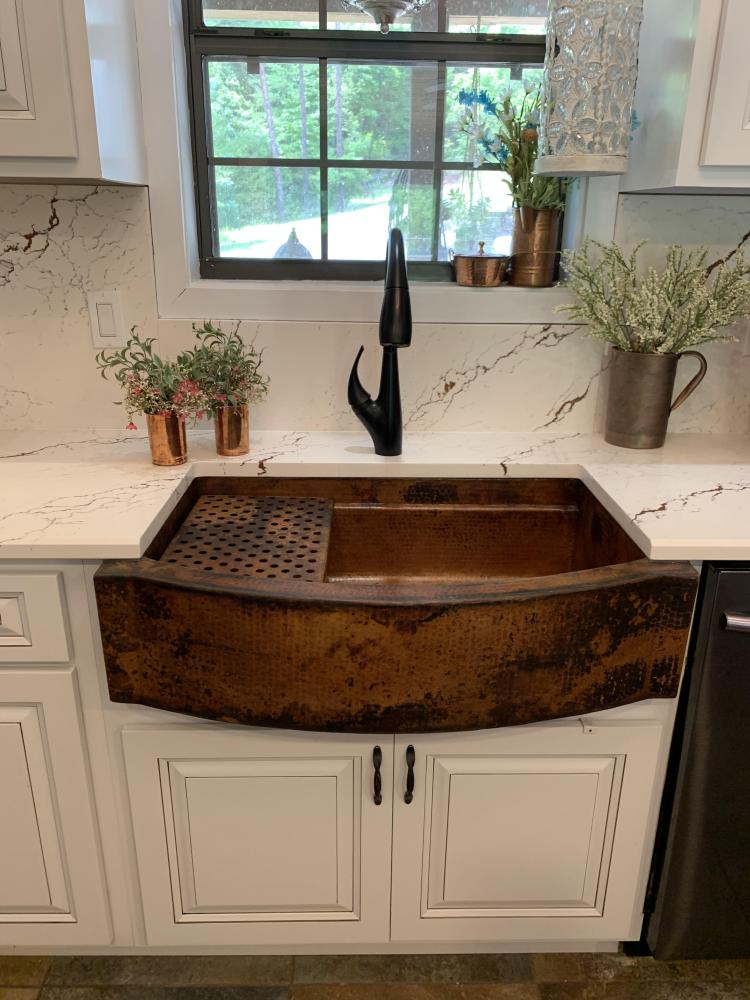
Modern Kitchens and Trends: 2010 - Present
Today’s kitchens have integrated some popular trends, while at the same time bidding farewell to several mainstays of the past decades.
- Stainless steel is not quite as popular as it once was, although it will probably always have a place in the kitchen. Black stainless steel offers an attractive, fresh variation.
- Genuine marble countertops are still popular but due to the difficult upkeep, countertops made from other materials are making their way into home kitchens. Quartz is much easier to maintain and is customizable.
- Completely white kitchens have given way to the need for added visual interest.
- Glossy, slick appliances and finishings are being replaced with subtle textures and natural materials.
- Outdoor Kitchens are very much in vogue.
There is a clear effort to reject the minimalist look that kitchens embraced in previous years. Stainless steel, popular for so long, is being rejected in favor of other options. Genuine marble countertops are also a casualty of the times, and due to the difficulty of maintaining marble over long periods. New looks for today’s kitchens include pops of color in otherwise white kitchens. This can mean upholstery or colored cabinets. Popular colors include denim, hunter green, and greyish blue shades. Matte, not shiny, black cabinets are also trending. Modern kitchens have ample storage neatly concealed. One of the biggest changes in recent times for kitchen design is a shift to open shelving rather than upper kitchen cabinets. Open shelving is made of glass, metal, or wood and gives a spacious feel to the kitchen. Decorative backsplashes give the kitchen personality. Mirrored backsplashes are popular. Contrasting textures are the norm in kitchen decor. Fixtures and hardware offer additional kitchen design opportunities. Copper, pewter, and gunmetal add interest to faucets, levers, and handles. Brass is still being used, but other metals are very popular right now. Leather is another material making its way into today’s kitchen design. Hanging lights can be strategically placed in the kitchen not only for illumination but to guide the eye to see spaces as different areas. Currently popular are Italian-inspired, jewelry-like, hanging pendant lights. Today's kitchen focus is on achieving a style with a subtle, not brash, look. Wood, stone, and tiles are popular mediums. Hand-made kitchen tiles are created from terra cotta. There is a noticeable nod to wood, with extensive butcher block countertops, large walk-in pantries, and even old-style kitchen plate racks appearing in many kitchens.
Range Hoods
Improvements in range hoods, or exhaust hoods, in the 1920s and 1930s paved the way for today’s sleek options. Range hoods can be convertible, vented, or non-vented, and can be copper, brass, or stainless steel. The range hood has dramatically evolved. Now range hoods are much slimmer than ranges of kitchens in decades past. The style of range hood usually depends on the style of the range. Although not often considered the most important part of the kitchen, the range hood is responsible for removing smoke and odors, improving kitchen air quality, venting heat out of the kitchen, and reducing the risk of carbon monoxide poisoning. Copper influences are popular throughout the modern kitchen. Besides fixtures and hardware, prominently displayed copper pans, pots, and serving ware are beautiful as well as practical.
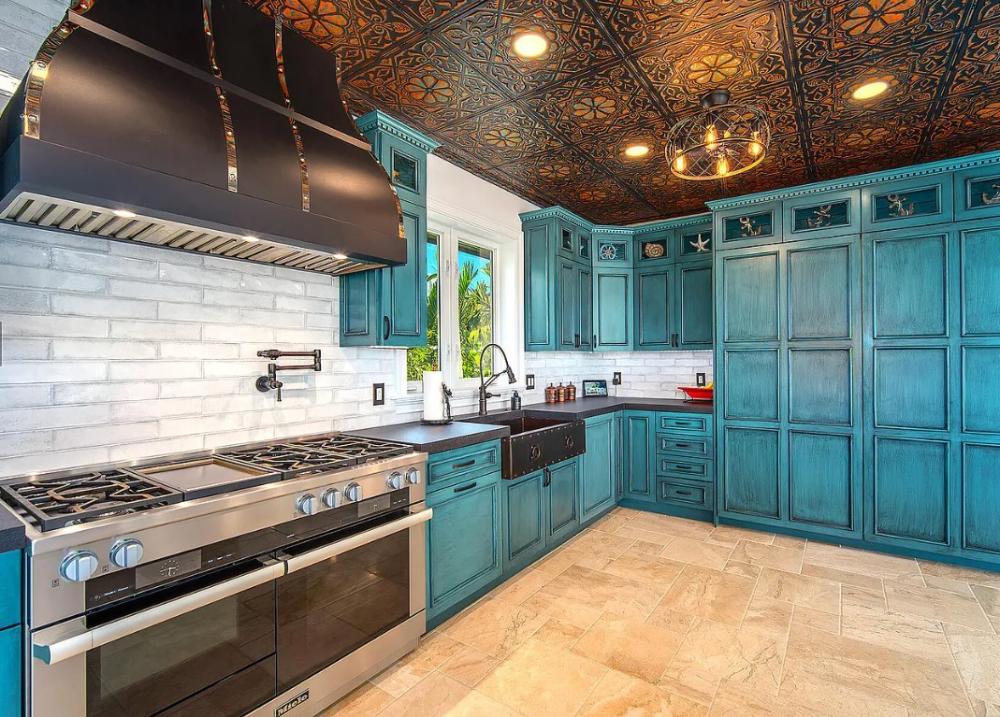
Technology
Today’s kitchens, like all other rooms in the home, continually evolve as technology offers new opportunities and conveniences. Range hoods, lights, wine systems, and appliances, including coffee or espresso makers, can all be programmed and activated using voice-activated technology and wifi. Today’s cook has a virtual assistant in the kitchen.
Kitchens of the Famous: Kim Kardashian and Kanye West
Kim Kardashian and Kanye West’s striking kitchen reflects their desire for a living space reflecting beauty, spirituality, positive energy, purity, and light. Kanye and Kim selected Belgian architect Axel Vervoordt to help come up with innovative design ideas to match their vision for their latest house. Their new home has not one, but two kitchens, as well as multiple refrigerators, freezers, and pantries. A walk-in refrigerator with wire shelves is stocked with organic fruits and vegetables. It resembles a professional restaurant walk-in cooler. In the Kardashian-West kitchen, there is no plastic. Most containers have been replaced with glass, in keeping with their philosophy. Kitchen gadgets and stainless steel appliances include a frozen yogurt machine. Everything is organized in a kid-friendly manner, with coordinated containers and food dispensers. Modern Trends: Outdoor Kitchens An outdoor kitchen is an organized area outside of the home where meals can be prepared, cooked, served, and cleaned up. Possible cooking appliances include a grill, pizza oven, cooktop, or a stove. Outdoor kitchens are very popular in warmer climates and during the summer.
What is so appealing about outdoor kitchens?
Outdoor kitchens make entertaining fun and simple, whether for a small dinner party or a large-scale event. Less electricity is used and the home remains much cooler when the cooking is done outside. If you enjoy barbecuing and grilling outside, having an outdoor kitchen saves time and steps because there is no back and forth between the kitchen inside the house to the grilling area. It also eliminates cooking odors inside the home. An outdoor kitchen can be as simple or as sophisticated as desired. It can include a sink, refrigerator, and stove. An outdoor kitchen can be located in the patio area or constructed on a supported deck. Most outdoor kitchens feature a protective covering to shield it from bad weather and provide relief from the hot summer sun. Lighting and music can provide the perfect finishing touches to an outdoor kitchen ready for entertaining.
What Makes Certain Kitchen Styles and Materials Timeless: Copper
Throughout the kitchen’s history, styles come and go, but some, like fashion, remain popular for many years. White kitchens, the popularity of stainless steel, and the kitchen table are examples. Copper is the enduring metal of the kitchen. It is not used in every kitchen. It is not always the style of the moment, yet it has been a welcome part of most kitchens since ancient times. Mesopotamian and ancient Egyptian cooks forged eating utensils, cooking containers, water containers, and ladles from copper. Artifacts that remained intact and were made from copper have been excavated by archaeologists. Did you know Paul Revere was a self-taught coppersmith? Before the Revolutionary War, Revere even made political cartoons by engraving copper plates. Copper cookware was the preferred choice in the 1800s for fine establishments like restaurants and hotels. In 1830, in a little village near Normandy, France, Ernest Mauviel opened the Mauviel copper cookware business that became world-renowned for its quality. The French village, Villedieu-les-Poêles, has been manufacturing copper for over 800 years. Copper is strikingly beautiful and a favorite way to add warmth and depth to any kitchen. Well-made copper pots last hundreds of years and are passed down through the generations. Part of copper’s popularity in the kitchen is that copper is an excellent metal for conducting heat. Copper is recyclable, lightweight but sturdy, and it does not rust. Copper also has strong antibacterial properties. A peek inside Julia Child’s kitchen reveals her love of copper. Copper pots, utensils, and the large overhead pot rack filled her kitchen with personality and flair. Copper has always been expensive and remains so today. Quality copper cookware is crafted by skilled coppersmiths and lined with stainless steel or tin. At times, the lining may need to be replaced, but the cookware itself stands the test of time and is usable for decades. It is common now for long-lasting, durable 18/10 stainless steel instead of tin to line copper cookware.
The Kitchen Continues to Transform in Appearance and Functionality
The evolution of the kitchen continues today. From early times to the present, from ancient China to ancient Egypt, to Europe, to North America, the kitchen has transformed from a utilitarian preparation area to a welcoming core of everyone’s home. Today’s kitchen is the outward reflection of the cook’s personality, imagination, taste, and style, combined with modern technologies, social and economic influences, appliances, and available space to work with. Other rooms of the home share insights into history, what is in style at the moment, and design trends. The kitchen reflects these things, but also allows a glimpse into the true core of the home.
The Future Of The Kitchen
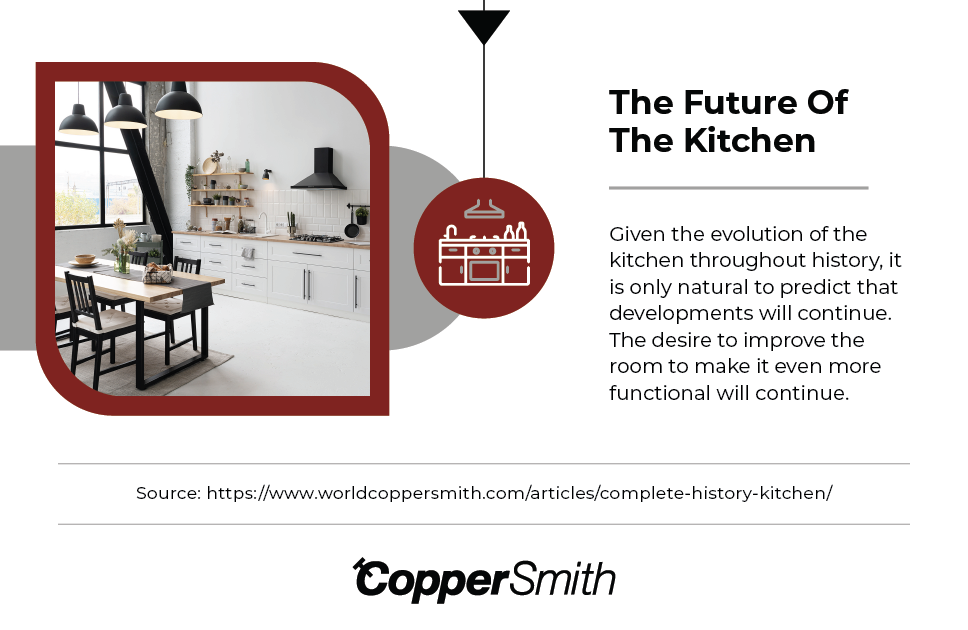
Given the evolution of the kitchen throughout history, it is only natural to predict that developments will continue. The desire to improve the
room to make it even more functional will continue.
Smart Technology
The next evolution will likely involve making kitchens smarter using a combination of computers and AI. These systems have the capacity to improve functionality while reducing wastage. For instance, refrigerators may have sensors that can monitor food and warn you of impending spoilage. They may also come with advanced technology that orders replacement staples on your behalf or via an app on your phone.
Induction Technology
Induction-based technology is also likely to play a significant role in kitchens of the future. It can heat and cool items without actually becoming warm itself or relying on any parts that could potentially cause a fire.
Induction heating uses magnetic components hidden under the cooktop to heat pots and pans made of specific materials. The genius of the technology is that it is able to heat an entire region and users can place pots and pans anywhere on the surface. There are no naked flames or hot coils, improving fire safety, especially in apartments.
Some experts believe the fridges of the future will also use induction technology. Induction cooling tables inside “cooling containers” will instantly chill food, eliminating the need to cool passively via conduction, as in standard refrigerators. Refrigerators may also benefit from bespoke “cooling zones” that chill foods to optimal temperatures. The Mushroom Council recommends storing mushrooms at 34 to 38°F while the state authorities suggest keeping meat and poultry below 41.5°F. Hence, future refrigerators may improve food quality by offering various zones.
Sustainability
Finally, the kitchen of tomorrow is likely to place a greater emphasis on sustainability. Greener appliances will drive lower energy and water usage, helping householders meet various net zero targets by mid-century.
For example, dishwashers may retain wastewater, letting homeowners use it to water plants. Similarly, food composters will take food waste and enable homeowners to turn it into soil on-site, helping to complete the circular economy. These facts are something to think of when planning for your next kitchen remodeling costs.
Lastly, we may see the development of even more efficient appliances. Range hoods may benefit from enhanced motors and fan blades while dishwashers could use energy derived from heat pumps.
References
- https://www.housebeautiful.com/room-decorating/kitchens/g3943/100-years-kitchen/
- https://www.egypttoday.com/Article/4/35945/Ancient-Egypt-VI-Ancient-Egyptian-cuisine
- https://study.com/academy/lesson/colonial-kitchen-fireplace-designs.html
- https://www.daringgourmet.com/the-evolution-of-the-american-kitchen/
- https://www.mbsinteriors.com/evolution-of-the-american-kitchen/
- https://www.insider.com/then-and-now-how-us-kitchens-have-evolved-2019-3#by-the-1940s-kitchens-became-more-user-friendly-8
- https://www.encyclopedia.com/food/encyclopedias-almanacs-transcripts-and-maps/ancient-kitchen
- https://www.almanac.com/content/brief-history-woodstove
- http://www.madehow.com/Volume-4/Cast-Iron-Stove.html
- http://www.castlesandmanorhouses.com/life_01_rooms.htm
- https://study.com/academy/lesson/colonial-kitchen-fireplace-designs.html
- http://oldhouseliving.com/2014/01/27/historic-kitchens-1890-to-1920-design-and-development/2/
- https://www.mcfarlandhistorical.org/portfolio_page/1920s-kitchen/
- https://rumford.com
- https://nonagon.style/frankfurt-kitchen-design-history/ (Margarete Schütte-Lihotzky)
- https://www2.le.ac.uk/projects/social-worlds/all-articles/lifelong-learning/the-kitchen-table
- https://www.mountvernon.org/the-estate-gardens/location/kitchen/ (Link to Mt. Vernon kitchen virtual tour)

